Excerpts from Jim Conrad's
Naturalist Newsletter
entry dated May 19, 2022, notes from a camping trip among hills about 7kms ENE of Tequisquiapan, Querétaro state, MÉXICO
elevation about 2000m (6600 ft), near N20.57°, W99.85°
"GIANT MESQUITE BUG" (nymph instar #5)
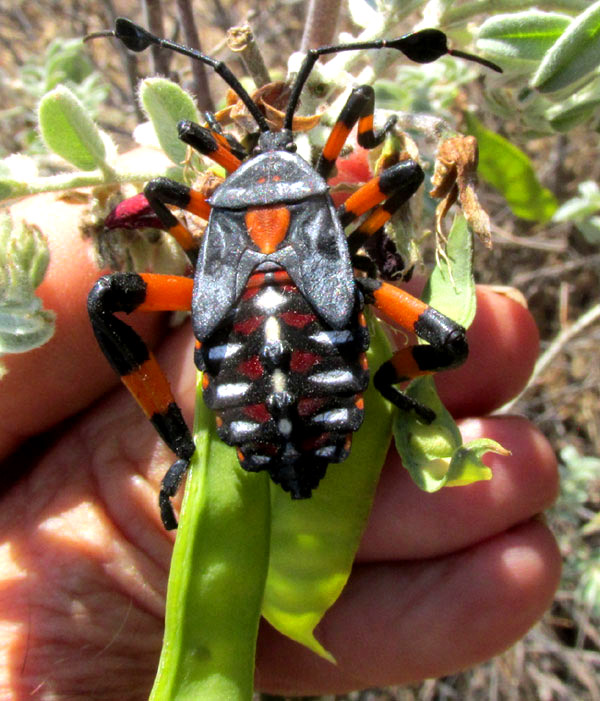
At the hot, dusty, glaringly sunny end of the dry season, the landscape here is mostly brown and gray, so anything showing a little color is very noticeable. A dense population of the above large bugs on many Brongniartia Trees currently issuing leaves and flowers was one of those eye catching things. Comparing this bug's size with my fingers in the background indicates how large it is.
Here the word "bug" is being used in its formal sense. In regular English,"bug" often is used for any insect at all, especially bothersome ones. However, often about 26 insect orders are recognized -- the Beetle Order, the Butterfly & Moth Order, the Dragonfly & Damselfly Order -- and the above-pictured bug belongs to the True Bug Order, the Hemiptera.
Members of the True Bug Order can be recognized by their bent, straw-like mouthparts for sucking juices, fairly long, conspicuous antennae with four or five segments, and their set of two forewings, which are hard at their bases but mostly membrane-like, and hide the pair of hind wings.
The bug in our picture, however, has undeveloped wings, because it's a "nymph" -- one of the immature stages of an insect undergoing incomplete metamorphosis (egg-nymph-adult) instead of complete (egg-larva-pupa-adult). Various nymph stages lead up to the final metamorphosis producing the winged adult, each nymph stage a little larger than the last. The picture shows a later-stage nymph, with the first indication of wings, the dark, shiny ovals beside the bug's lower two pairs of legs. If you search for other pictures of this insect on the Internet, if you see an adult, it'll bear wings, it'll look different from the nymph in our picture
Starting with the fact that our nymphs were recognizable as true bugs, and using techniques described on our Insect Identification page, it was easy to figure out which bug we had. Once its family was recognized -- the mostly tropical and subtropical Coreidae, whose members sometimes are known as leaf-footed bugs, squash bugs and other English names. An image search on the keywords "Coreidae Mexico" turned up a page of thumbnail pictures of many Mexican Coreidae species, with our bug, identified, among them.
It's THASUS GIGAS, which I'm calling the "Giant Mesquite Bug," placing the name between quotation marks because no one else seems to be using that name for the species. In the southwestern US there's a closely related species, Thasus neocalifornicus, for which the same name is used. However, some Mexican government websites apply to our Thasus gigas the Spanish name Chinche gigante del Mezquite, which more or less means "Giant Mesquite Bug." BugGuide.Net doesn't include this as a species occurring in the US. Apparently it's endemic just to Mexico, appearing in most semi-arid regions dominated by mesquite and acacia trees.
Thasus gigas is described as abundant and gregarious, and that's the way they looked on certain Brongniartia Trees, though they were absent on many. The impression was that numerous eggs had been laid on scattered trees, the eggs hatched, and the nymphs not having wings didn't spread to neighboring trees without bugs. I read that the adults deposit their eggs in late August, mostly on mesquite trees but also other members of the Bean Family, like the Brongniartias. The nymphs hatch in October and by January and February have reached their second and third nymphal stages. The fourth stage appears in March to May, and the fifth from May to July. Winged adults can emerge from May to September. When disturbed, both the latter nymph stages and adults produce a stinking yellow juice to protect themselves. People harvesting them to eat know to wear gloves.
So, yes, in the semi-arid uplands of central Mexico Thasus gigas is considered by many to be good eating, especially by people with an Otomí background. Here in Querétaro they're eaten fried with various pungent herbs, and with salsa, chili peppers, cactus xoconostle-type fruits, garlic and salt.
In this area often people believe that eating Thasus gigas controls diabetes. A 2014 study by Nallely Monroy Moncayo and others, entitled "Is Ingestion of Thasus Gigas (Xamues) an Alimentary Culture or an Auxiliary Treatment for Type II Diabetes?" concluded that "... there is no evidence that ingestion of these insects can regulate blood glucose levels."
entry dated May 3, 2023, issued from near Tequisquiapan, elevation about 1,900m (6200 ft), N20.565°, W99.890°, Querétaro state, MÉXICO
(~N20.55°, ~W99.89°)
BRIGHTER COLORED INSTAR #5
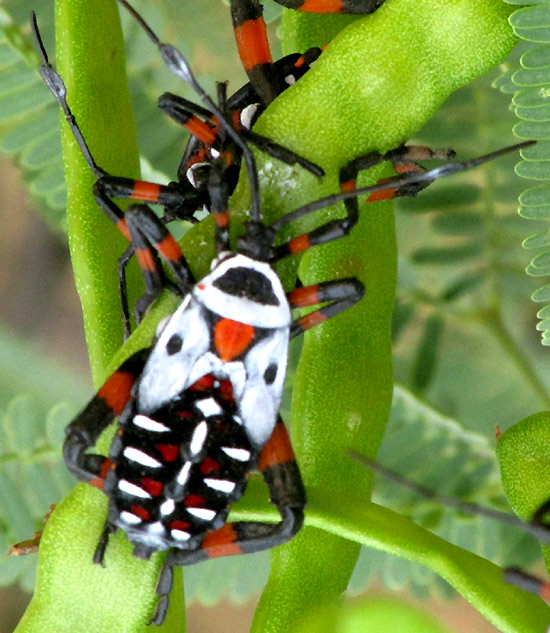
Most Internet pictures show a more strikingly colored instar #5, like the one shown above, in a group of about seven, sucking juices from a mesquite legume. I can't account for the differences. Maybe they are different aged instars #5.
entry dated March 30, 2023, issued from near Tequisquiapan, elevation about 1,900m (6200 ft), N20.565°, W99.890°, Querétaro state, MÉXICO
(~N20.55°, ~W99.89°)
NYMPHS ON WISTERIA(instar #2)
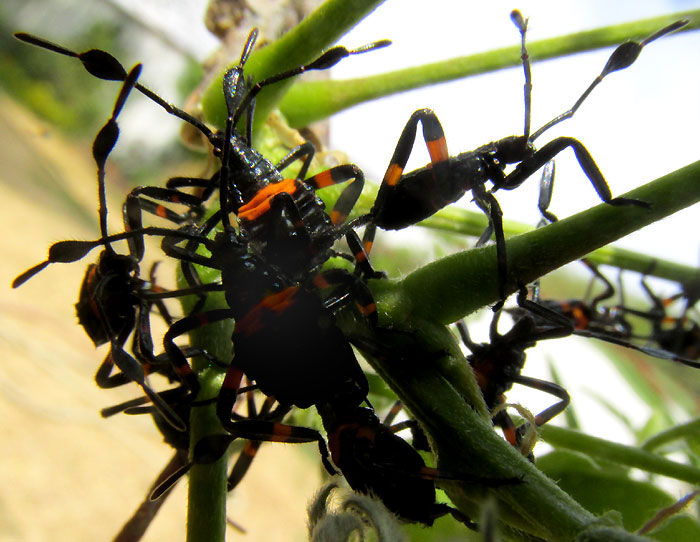
Now as hot weather is returning, in a walled-in backyard at the village's edge, a planted, waist-high wisteria was issuing new growth. The above cluster of Thasus gigas nymphs formed a black smudge where they appeared to be feeding on a rapidly elongating stem. At first I didn't recognize them as our "Giant Mesquite Bug" because they were so small, their bodies without antenna only roughly 5mm long (0.2 inch). That compares with the earlier one seen in mid May, which was about 36mm long (1.4 inch).
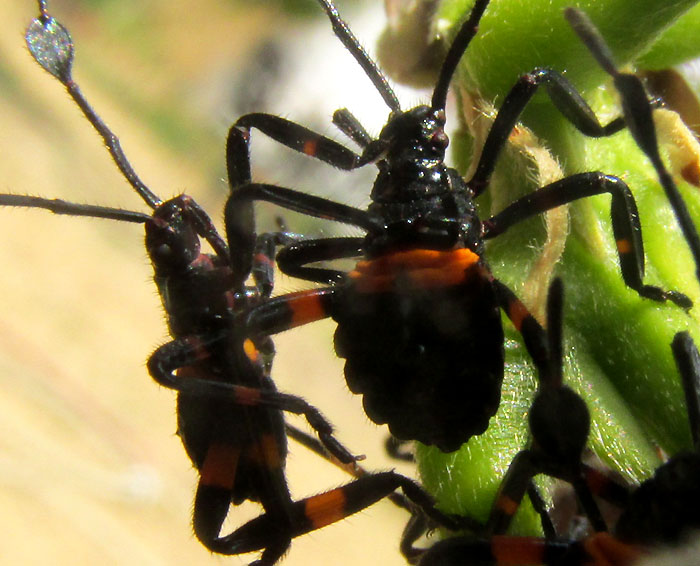
The above shows two nymphs closer up.
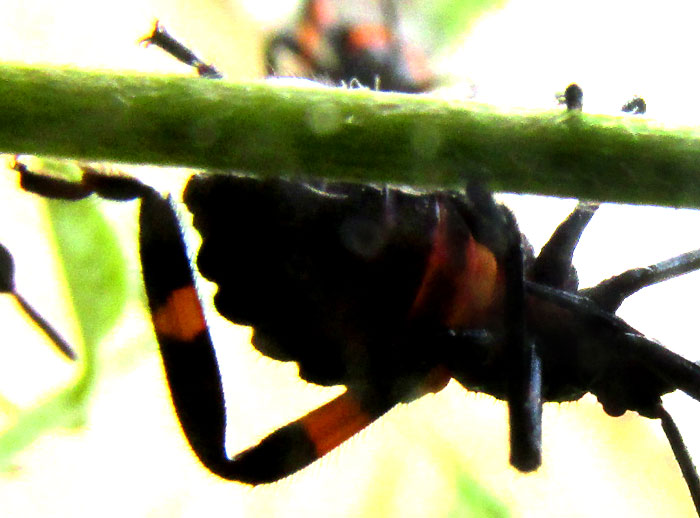
The above shows one from below.
Referring to the fine 1995 study by Harry Brailovsky and others entitled "Estadios Ninfales de los Coreidos del Valle de Tehuacán, Puebla, México (Hemiptera-Hereroptera) II Especies Asociated a Huizacheras (Acacia spp.) y Mezquiteras (Prosopis spp.): Mozena lunata, Pachylis hector, Savius jurgiosus jurgiosus y Thasus gigus" -- providing drawings and detailed measurements of four hemipterids, including our Thasus gigas -- our nymphs appear to be in their second instars. The earlier nymphs seen in May last year appear have been in the last instar before the adult stage, the fifth.
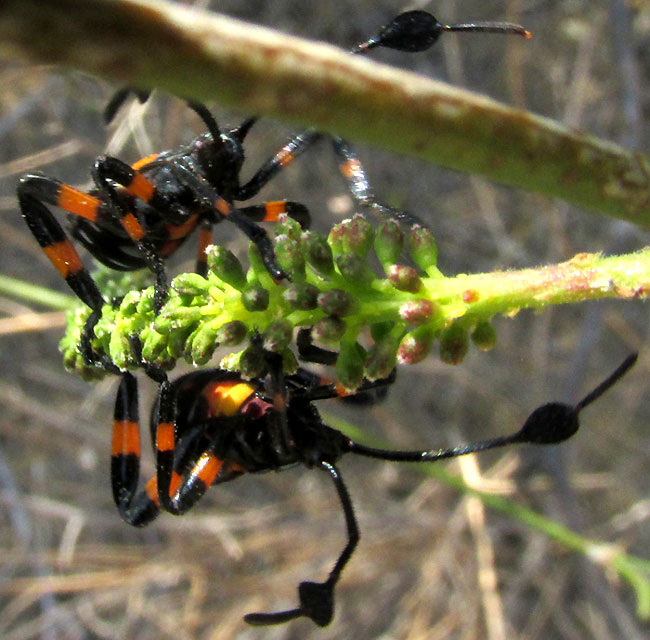
The above picture documents nymphs in part of a second cluster seen the same day the above Wisteria nymphs were photographed. They clustered on an immature inflorescence of Smooth Mesquite, Prosopis laevigata. Our "Giant Mesquite Bug" appears on many lists and the Internet abounds in pictures of them, but there's much less information about their lives. However, they're known to be "monophagous" -- feeding on just one kind of plant, which in this case is various members of the Bean Family, the Fabaceae, and that includes Wisterias.
Here it can also be reported that when a cluster of nymphs is approached about a finger-length away by a camera, even if the branch hasn't been shaken, some nymphs will fall to the ground while others run here and there. Also, on the day the above wisteria pictures were taken, about a hundred mesquites were scanned as I walked by them, but only one young, understory mesquite about chest high hosted a cluster of nymphs. This species often is described as common, but here they're not too common.
Thasus gigas isn't strictly Mexican. It occurs from northwestern Mexico and in southwestern Texas along the Mexican border, south into Nicaragua, but is missing in the big Chihuahuan grasslands and the Yucatan Peninsula.
People still do eat these. I suspect that in the old days eating them was a matter of frying them with some herbs and wrapping a tortilla around the result. However, now there are recipes resulting in bowls of black bodies with sprawling legs and antennas mingled with stir-fried, chopped vegetables. At this writing you can see such a dish in an online México Desconocido article entitled Xamues: una delicia prehispánica del Valle del Mezquital. Those bugs appear to be nymphs in the fifth instar, the one before the adult is formed. I'd guess that the "husk," or exoskeleton, of the nymphs is less crunchy than that of the adults. On the above page, note that here they call our bugs xamues. In Mexico they're also called tantarria, shashues, chinche de mesquite and ya xá ue.
entry dated April 2, 2023, issued from near Tequisquiapan, elevation about 1,900m (6200 ft), N20.565°, W99.890°, Querétaro state, MÉXICO
(~N20.55°, ~W99.89°)
NYMPHS ON GROUND (instar #4)
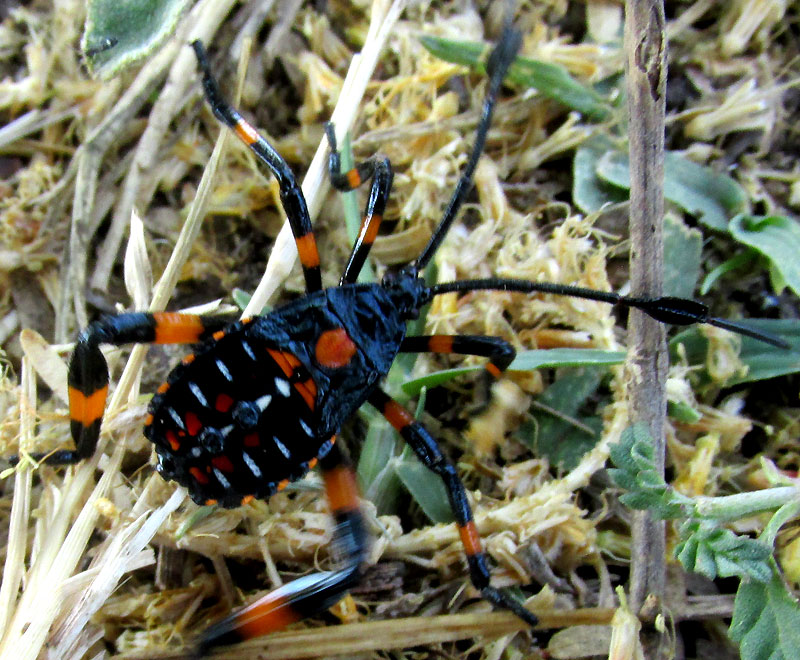
The above shows one of two Thasus gigas nymphs found on the ground beneath a large mesquite tree. Referring to the drawings in the above-mentioned 1995 work by Harry Brailovsky and others, I think here we see instar #4. Note that the wings are beginning to bud, their tips reaching a point above the attachment of the hind legs. Also the bottom of the abdomen is somewhat rounded.
The bugs were alive and moving. They appeared close to one another as if they had fallen from their perch in the tree. No other mesquite was within easy walking distance for a nymph, and these weren't orienting toward either the trunk of the tree from which they fell, or the next closest. The nymphs on the wisteria featured in the previous entry on this date remained in the early stage shown in the photographs.
UPDATE: On April 5, all the wisteria's nymphs disappeared. Over the days since their discovery their numbers had gradually diminished.
entry dated May 9, 2023, issued from near Tequisquiapan, elevation about 1,900m (6200 ft), N20.565°, W99.890°, Querétaro state, MÉXICO
(~N20.55°, ~W99.89°)
AN ADULT
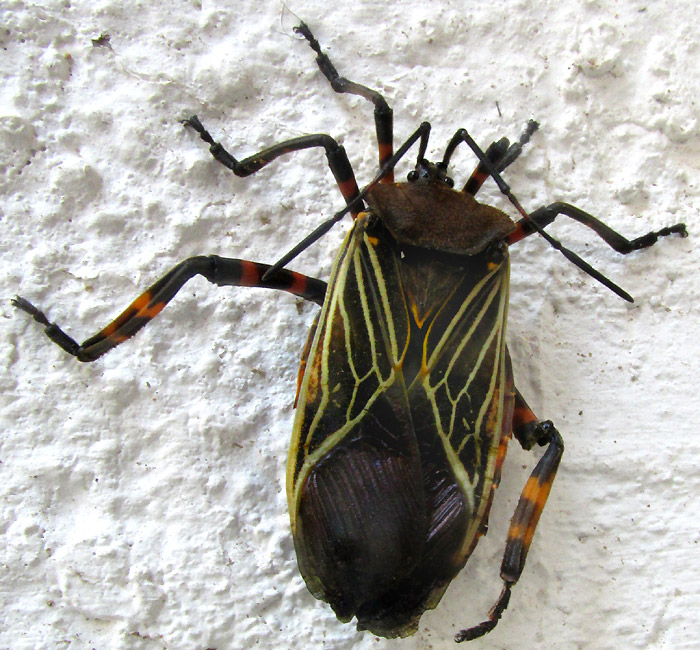
A couple of days after the first good rains for months, the above adult turned up on a lime-painted wall of a courtyard, not far from a mesquite tree's branches extending over the courtyard. The colors are a little less vivid than seen in pictures of other adults, and the third antenna segment isn't dilated as expected. Possibly this is because the individual had just emerged from its 5th instar. Maybe we're just looking at the third antenna segments from their sides.
entry dated April 6, 2023, with notes from the lower slope of hill south of El Cerrito, 5kms south of Tequisquiapan; bedrock volcanic andesite, an intermediate rock between basalt and rhyolite; elevation about 2,000m (6600 ft), Querétaro state, MÉXICO
(~N20.47°, ~W99.89°)
DEAD, SUN-BLEACHED ADULT
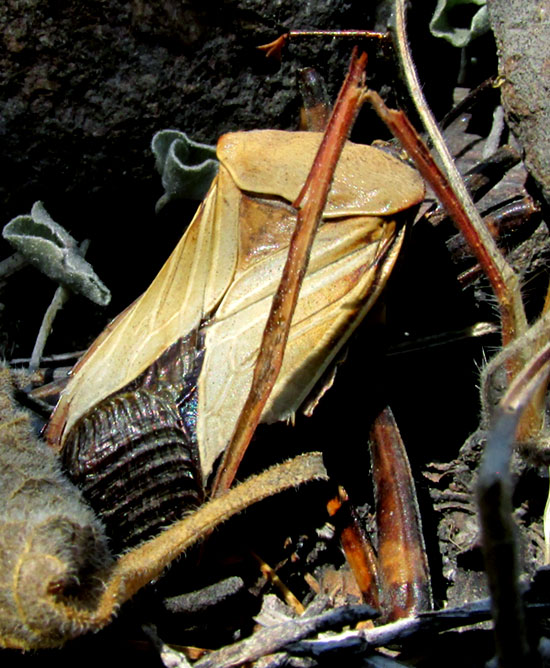
The above big bug quietly huddled into a corner between a rock and a mesquite tree. Stealthily I brought the camera closer and closer, and still it didn't move. It turned out to be dead, very brittle, and sun-bleached. In living adults the legs are much more conspicuously barred, and the front wings handsomely display white veins on a black background. On this one, I could get close enough to admire the vein patterns:
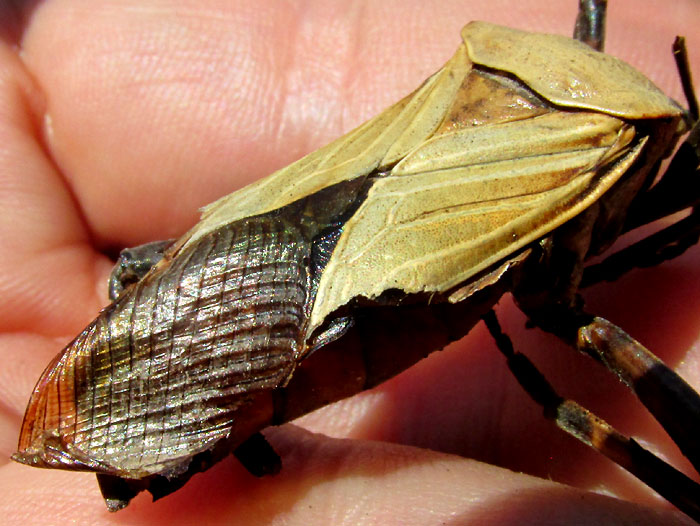
entry dated August 11, 2023, issued from near Tequisquiapan, elevation about 1,900m (6200 ft), ~N20.57°, ~ W99.89°, Querétaro state, MÉXICO
ADULT LATER IN SEASON
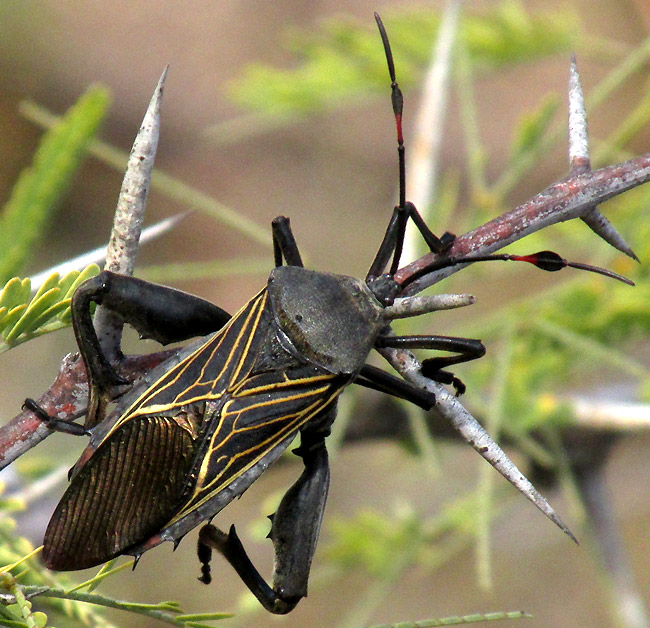
Adults in mid August mostly wear the subdued colors shown above. Note the hint of red remaining on the mid antenna segment on the picture's right side.
entry dated April 15, 2023, issued from near Tequisquiapan, elevation about 1,900m (6200 ft), N20.565°, W99.890°, Querétaro state, MÉXICO
(~N20.55°, ~W99.89°)
TALKING TO AN OLD EATER OF XAMUES
When I saw old Don Germán and his dog coming down the trail, I knew exactly what I wanted to ask him this time: "Did you ever eat these big red bugs appearing on mesquite trees nowadays and, if so, how did you do it?" Don Germán's eyes sparkled and said:
"Once I was gathering firewood way out in the hills and I came across a bunch of bushes just covered with xamues, everywhere, everywhere. Next day I went back with a bag and soon had it full of them. You spread something on the ground, then shake the branches and they just fall off. When you pick them up, it scares them and they pee on you. The pee turns pale yellow-brown on your fingers, but it doesn't do any harm. It's their way of defending themselves. Back home we ate them all and I still remember how we ate so much and enjoyed it! I went back in two days for more, but they were all gone. Somebody else had found them, too."
I asked how he prepared them.
"On the comal," he said. Comals are round, flat griddles with smooth cooking surfaces, suspended over fire, for preparing tortillas and charring or toasting many traditional foods. He said you don't remove the legs or head, for they become soft. Because xamues burn easily on a hot comal, you have to keep stirring them around. The adults aren't eaten, but rather the large instar shown atop this page, instar #5, which metamorphoses into the winged adult. And how are xamues served?
"We like them mixed with guacamole," he said. Maybe put a dollop of that on a hot tortilla, a little salt, spritz with a little salsa or lemon juice, and it's good!"
Finally he added:
But xamues are harder to find nowadays. Now you hardly ever see them in such numbers as I did back then. There's just a few here and there, not worth picking.